|
Exhibition Hall 17:00 - 18:00 |
|
|
|
Computer # |
|
3572.
 |
1 |
In-Bore MRI-Guided Transperineal Prostate Biopsy using 4-DOF
Needle-Guide Manipulator 
Junichi Tokuda1, Kemal Tuncali1, Gang
Li2, Nirav Patel2, Tamas Heffter3,
Gregory S Fischer2, Iulian I Iordachita4,
Everette Clif Burdette 3,
Nobuhiko Hata1, and Clare M Tempany1
1Department of Radiology, Brigham and Women's
Hospital, Boston, MA, United States, 2Department
of Mechanical Engineering, Worcester Polytechnic Institute,
Worcester, MA, United States, 3Acoustic
MedSystems Inc., Savoy, IL, United States, 4Department
Of Mechanical Engineering, Johns Hopkins University,
Baltimore, MD, United States
We present the clinical feasibility of our MRI-compatible
4-DOF needle-guide manipulator for in-bore MRI-guided
transperineal prostate biopsy. Total 11 men were biopsied in
a 3T MRI scanner using this manipulator. All 11 procedures
were successfully performed in 102.6±24.5 minutes with
targeting errors of 4.9±2.9 mm. The targeting errors were
consistent with other clinical studies. Pathology results
confirmed prostate cancer with Gleason score ≥ 6 in 5/6 men
with previous negative TRUS biopsies, and upgraded 2/5 men
on active surveillance to clinically significant cancer with
Gleason score 7. In conclusion, In-bore MRI-guided prostate
biopsy using the manipulator was feasible.
|
|
3573.
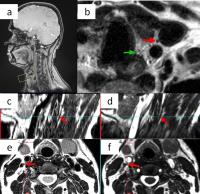 |
2 |
Motion compensated high resolution MR Imaging of Vagus and
Recurrent Laryngeal Nerves with Novel Phase-based Navigation
Sequences 
Ravi Teja Seethamraju1, Jayender Jagadeesan2,
Vera Kimbrell2, Aida Faria2, Thomas C
Lee2, and Daniel T Ruan3
1MR R&D, Siemens Healthcare, Boston, MA, United
States, 2Radiology,
Brigham and Women's Hospital, Boston, MA, United States, 3Endocrine
Surgery, Brigham and Women's Hospital, Boston, MA, United
States
Diagnostic imaging of the recurrent laryngeal (RLN) and
vagus nerves (VN) could help in surgical planning and in
minimizing the risk of damage to the nerves. However,
imaging these nerves is technically challenging due to their
size, location, and physiological motions such as breathing
and swallowing. The RLN and VN can be visualized on the CISS
and T2 TSE, however with a novel phase navigator, the nerves
are better delineated on the motion-compensated T2 TSE
compared to the CISS which is un-navigated.
|
|
3574.
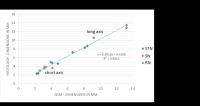 |
3 |
Geometry of Basal Ganglia nuclei in QSM and Histology in
Parkinson’s disease brains 
Carsten Stueber1,2, Alexey Dimov1,
Kofi Deh1, David Pitt2, and Yi Wang1
1Weill Cornell Medical College, New York, NY,
United States, 2Yale
School of Medicine, Yale University, New Haven, CT, United
States
Quantitative susceptibility mapping (QSM) provides a
quantitative MRI contrast, which reflects the local iron
concentration. Thus, QSM allows to determine the geometries
of iron-rich deep grey matter nuclei including substantia
nigra (SN) and subthalamic nucleus (STN). These basal nuclei
are of particular interest in Parkinson’s disease. However,
the measured dimensions need to be validated in histology
using post-mortem human brain tissue. In this work, we show
the concordance of the geometries measured in QSM and
histology using Perls’ iron stain, which opens the door to
use QSM as a pre-surgical mapping for deep brain stimulation
targeting the STN.
|
|
3575.
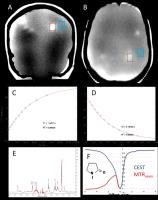 |
4 |
Multi-parametric MRI Characterization of a Polymer Gel Dosimetry
Phantom for Non-Invasive 3D Visualization of Radiation
Deposition in Gamma Knife Therapy 
Ivan E Dimitrov1,2 and
Strahinja Stojadinovic3
1Philips Medical Systems, Dallas, TX, United
States, 2Advanced
Imaging Research Center, UT Southwestern Medical Center,
Dallas, TX, United States, 3Radiation
Oncology, UT Southwestern Medical Center, Dallas, TX, United
States
Radiation therapy aims to maximize dose delivery to tumor
areas while minimizing the exposure to healthy tissue.
Quality control is required to ensure that the delivered
dose closely matches the calculated dose. We performed a
patient-specific quality assurance for cranial radiotherapy
using MRI to visualize delivered radiation dose. We utilized
an anthropomorphic 3D printed head phantom filled with
polymer gel that was scanned before and after exposure to
Gamma Knife irradiation. Irradiation changed the
polymerization state of the gel and multi-parametric (T1,
T2, MR Spectroscopy, CEST) quantitative dose-imaging maps
were generated that may lead to optimized patient-specific
dose delivery planning.
|
|
3576.
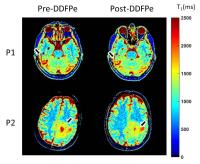 |
5 |
TOLD MRI Validation of Reversal of Tumor Hypoxia in Glioblastoma
with a Novel Oxygen Therapeutic 
Heling Zhou1, David Wilson2, Jason
Lickliter3, Jeremy Ruben4, Natarajan
Raghunand5, Michael Sellenger6, Ralph
P Mason7, and Evan Unger2,8
1UT Southwestern Medical Center, Dallas, TX,
United States, 2NuvOx
Pharma, Tucson, AZ, United States, 3Nucleus
Networks, Melbourne, Australia, 4William
Buckland Radiotherapy Centre, Melbourne, Australia, 5Moffitt
Cancer Center, Tampa, FL, United States, 6Alfred
Hospital, Prahran, Australia, 7Radiology,
UT Southwestern Medical Center, Dallas, TX, United States, 8Medical
Imaging, The University of Arizona, Tucson, AZ, United
States
Glioblastoma multiforme (GBM) is known to be a hypoxic tumor
and hypoxia adversely affects response to radiation therapy.
Dodecafluoropentane emulsion (DDFPe) can improve
oxygenation. Tissue oxygen level dependent (TOLD) MRI is an
oxygen sensitive imaging technique which is used in this
study to assess the improvement of oxygenation after
administration of DDFPe. Two different doses were tested and
each showed decreased T1 indicating
improved oxygenation.
|
|
3577.
 |
6 |
Towards DWI Guidance of Percutaneous Biopsies using Dual Echo
Steady State Sequence: Qualitative Assessment in Liver 
Elena A Kaye1, Kristin L Granlund2,
Stephen B Solomon2, and Majid Maybody2
1Medical Physics, Memorial Sloan Kettering Cancer
Center, New York, NY, United States, 2Radiology,
Memorial Sloan Kettering Cancer Center, New York, NY, United
States
Acquisition of a viable tissue sample is critical to success
of a biopsy. DWI could help differentiate between viable and
necrotic tissue during the procedure, however, EPI-DWI is
not suitable in a percutaneous-biopsy setting due to
geometric distortions. DW Dual Echo Steady State (DESS)
sequence allows acquisition of 3D undistorted DWI images.
This study evaluated the application of DW-DESS during an
MR-guided liver biopsy in two patients. Using single
breath-hold acquisition, DW-DESS image depicted a liver
lesion sharper and less distorted than EPI-DWI. DW-DESS also
allowed DWI in the presence of a biopsy needle without
distortions of EPI.
|
|
3578.
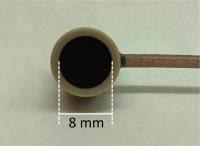 |
7 |
Scannerless real-time MRI 
Frank Preiswerk1, Cheng-Chieh Cheng1,
Sanjay S. Yengul1,2, Lawrence P. Panych1,
and Bruno Madore1
1Radiology, Brigham and Women's Hospital, Harvard
Medical School, Boston, MA, United States, 2Mechanical
Engineering, Boston University, Boston, MA, United States
MRI can provide favorable image quality for image-guided
interventions, but both magnetic field of the scanner and
limited patient access inside the bore impose many
limitations on image-guidance endeavors. The aim of this
work was to estimate MRI of respiratory organ motion outside
the scanner, which allows for a wider range of
interventional applications. A single-element ultrasound
transducer was used as a surrogate for the MR scanner
outside the bore, after the correlation between both signals
had been learned in a preceding training phase. Validation
of estimated MR images outside the bore was performed using
tracked 2D ultrasound.
|
|
3579.
 |
8 |
Real-Time Golden Angle Radial iSSFP for Interventional MRI 
Samantha Mikaiel1,2, Thomas Boyd Martin1,2,
Kyung Sung1,2, and Holden H Wu1,2
1Radiological Sciences, University of California,
Los Angeles, Los Angeles, CA, United States, 2Biomedical
Physics, University of California, Los Angeles, Los Angeles,
CA, United States
Real-time visualization is crucial to the success of
MRI-guided minimally invasive cancer interventions. In this
work we combine iSSFP with a golden-angle(GA) ordered radial
trajectory and non-Cartesian parallel imaging to create a
new real-time MRI sequence with good tissue contrast while
suppressing bSSFP banding artifacts. Phantom and volunteer
data were acquired and reconstructed using a combined
sliding-window SPIRiT algorithm, at different frame rates,
showing the capability of the sequence to achieve real-time
imaging. These advantages of GA Radial iSSFP show its
potential for improving real-time MRI-guided interventions.
|
|
3580.
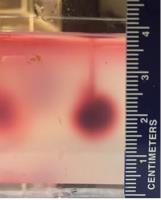 |
9 |
The Development of Tissue Mimicking Gels 
Peter Andrew Hardy1, Christopher J Norsigian2,
Walter Witschey3, and Luke H Bradley2
1Radiology, University of Kentucky, Lexington,
KY, United States, 2Anatomy
& Neurobiology, University of Kentucky, Lexington, KY,
United States, 3Smilow
Center for Translational Research, University of
Pennsylvania, Philadelphia, PA, United States
Developing tissue mimicking materials can be helpful in
reducing the cost and duration of experiments which
otherwise require animals. We tested a variety of agarose
gels of different gel strength as suitable tissue mimicking
material for convection enhanced delivery. The results
demonstrate a significant difference in infusion volume and
we relate that, through MR measurements, to the mechanical
stiffness of the gels.
|
|
3581.
 |
10 |
A four-layer boundary element model for MRI-guided transcranial
magnetic stimulation 
Aapo Nummenmaa1 and
Matti Stenroos2
1Athinoula A. Martinos Center for Biomedical
Imaging, Department of Radiology, Massachusetts General
Hospital, Charlestown, MA, United States, 2Department
of Neuroscience and Biomedical Engineering, Aalto
University, Espoo, Finland
MRI-guided targeting and dosing has the potential increase
the consistency and efficacy of transcranial magnetic
stimulation (TMS). We propose a boundary element method
(BEM) approach for estimating the TMS-induced cortical
electric fields (E-fields). The method can be applied based
on standard T1/T2-weighted MRI data and can incorporate the
cerebrospinal fluid (CSF) as a separate conductivity
compartment. Our results show that the CSF layer may
increase the estimated E-field amplitudes up to 25%. The
effect of the CSF depends on the location and orientation of
the TMS coil/target in a rather intricate manner,
highlighting the importance of individualized, realistically
shaped models.
|
|
3582.
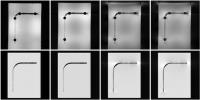 |
11 |
Measurement and Simulation of Susceptibility Artifacts in
Variable-TE Radial MRI: Application in an MR-safe Guidewire 
Katharina E. Schleicher1, Stefan Kroboth1,
Klaus Düring2, Michael Bock1, and Axel
Joachim Krafft1,3,4
1Dept. of Radiology - Medical Physics, University
Medical Center Freiburg, Freiburg, Germany, 2MaRVis
Medical GmbH, Hannover, Germany, 3German
Cancer Consortium (DKTK), Heidelberg, Germany,4German
Cancer Research Center (DKFZ), Heidelberg, Germany
A simulation framework is presented to optimize radial
acquisition schemes with variable echo times which are
designed to minimize the directional anisotropy of the
artifact of an MR-safe guidewire. The simulation results are
compared to measurements. We could theoretically and
experimentally verify that the homogeneity of the artifact
can be improved via the variable-TE method.
|
|
3583.
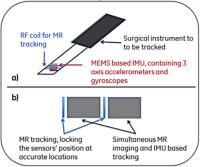 |
12 |
First steps towards concurrent, high rate imaging and MR
tracking using an inertial measurement unit (IMU) 
Robert Darrow1, Mauricio Castillo-Effen1,
Eric Fiveland1, Elizabeth Morris2, and
Ileana Hancu1
1GE Global Research Center, Niskayuna, NY, United
States, 2Memorial
Sloan Kettering Cancer Center, New York City, NY, United
States
Tissue motion during MR guided interventional procedures
leads to the desire to perform simultaneous high speed
tracking of the surgical instrument and imaging. In this
work, a novel approach for concurrent tracking and imaging,
based on an inertial measurement unit (IMU) and technology
from plane/missile tracking, is presented. While using
infrequent position updates for the IMU (that could be
provided by MR tracking), we have showed fast tracking
(166Hz) of the IMU sensor with ~2mm rms error.
|
|
3584.
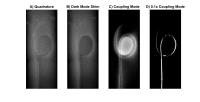 |
13 |
Interventional device visualisation using the coupling mode of a
PTx transmit array 
Francesco Padormo1, Arian Beqiri1,
Joseph V Hajnal1, and Shaihan Malik1
1Division of Imaging Sciences and Biomedical
Engineering, King's College London, London, United Kingdom
We propose a novel method to visualise guidewires in
interventional MRI procedures using the coupling mode of a
PTx array.
|
|
3585.
 |
14 |
Automatic high temporal and spatial resolution position
verification of an HDR brachytherapy source using subpixel
localization and SENSE 
Ellis Beld 1,
Marinus A. Moerland1, Frank Zijlstra2,
Jan J.W. Lagendijk1, Max A. Viergever2,
and Peter R. Seevinck2
1Department of Radiotherapy, UMC Utrecht,
Utrecht, Netherlands, 2Image
Sciences Institute, UMC Utrecht, Utrecht, Netherlands
In order to verify the positions of a high-dose-rate (HDR)
brachytherapy source during treatment, fast imaging and
post-processing are needed. To get high temporal
resolutions, the use of lower spatial resolutions in
combination with subpixel source localization and the use of
parallel imaging were introduced. MR artifacts were
simulated and correlated to the experimentally obtained
artifacts (by phase-only cross correlation) to determine the
position of the HDR source. It was shown that the described
method was fast enough for localization of an HDR
brachytherapy source in real-time and high accuracy and
precision (submillimeter scale) were achieved.
|
|
3586.
 |
15 |
Hindered diffusion of Gadolinium-based Contrast Agents in rat
brain extracellular micro-environment after ultrasound-induced
delivery 
Allegra Conti1,2, Rémi Magnin1,3,
Matthieu Gerstenmayer1, François Lux4,
Olivier Tillement4, Sébastien Mériaux 1,
Stefania Della Penna2, Gian Luca Romani2,
Erik Dumont3, Denis Le Bihan1, and
Benoît Larrat1
1CEA/DSV/I2BM/NeuroSpin, Gif Sur Yvette, France, 2Department
of Neuroscience, Imaging and Clinical Sciences, G.
D'Annunzio, University of Chieti and Pescara, Chieti, Italy, 3Image
Guided Therapy, Pessac, France, 4Université
Lyon 1, Lyon, France
We present here a new method to study the diffusion process
of Gadolinium-based Contrast Agents within the brain
extracellular space after the artificial Blood-Brain Barrier
opening induced by ultrasound. Four compounds were tested
(MultiHance, Gadovist, Dotarem and AGuIX). By estimating the
Free Diffusion Coefficients from in
vitro studies,
and the Apparent Diffusion Coefficients from in
vivo experiments,
an evaluation of the tortuosity (λ) in the right striatum of
11 Sprague-Dawley rats has been performed. The values of λ
are in agreement with literature and demonstrate that the
chosen permeabilization protocol maintains the integrity of
brain tissue.
|
|
3587.
 |
16 |
3D Histogram Analysis of Apparent Diffusion Coefficient Maps
Predicts Relief of Fibroid Symptoms after MR Imaging–guided
High-Intensity Focused Ultrasound Ablation -
Permission Withheld
HAO FU1,2, Chenxia Li1, Rong Wang1,
Jianxin Guo1, Bilgin Keserci3, and
Jian Yang1
1Department of Radiology, the First Affiliated
Hospital of Xi'an Jiaotong University, xi'an, China,
People's Republic of, 2MR
Marketing, Philips Healthcare, xi'an, China, People's
Republic of, 3MR
Therapy Clinical Science, Philips Healthcare, Seoul, Korea,
Republic of
The aim of the study was to investigate the variation among
screening fibroids through analysis of ADC histogram, in
order to predict fibroids residual NPV proportion (residual
NPV%=NPV at 6 months follow up/ NPV immediately after
treatment ) and patients Symptom Severity Score (SSS).
Thirty five patients who accepted MRgHIFU ablation were
divided into group 1 (residual NPV%≥20%) of 19 patients and
group 2 (residual NPV%<20%) of 16 patients, respectively.
The SSS of patients were obtained at two time-point,
screening and 6 months follow up. ADCmean, ADCq, kurtosis
and skewness are derived from ADC histogram. The results
showed that values of ADCmean, ADCq and kurtosis were
significant difference between two groups. The average SSS
reduction of group 1 between pre and post treatment was more
obvious than that of group 2. Therefore, histogram analysis
of ADC maps can provide the quantitative information to
predict fibroids ablation outcome and patients symptom
relief, which may be indicated as a useful screening tool to
guide patients selection for MRgHIFU ablation.
|
|
3588.
 |
17 |
Real-time MRI-guided interventions using rolling-diaphragm
hydrostatic actuators 
Samantha Mikaiel1,2, James Simonelli3,
David Lu1, Kyung Sung1,2, Tsu-Chin
Tsao3, and Holden H Wu1,2
1Radiological Sciences, University of California,
Los Angeles, Los Angeles, CA, United States, 2Biomedical
Physics, University of California, Los Angeles, Los Angeles,
CA, United States, 3Mechanical
and Aerospace Engineering, University of California, Los
Angeles, Los Angeles, CA, United States
In this work we investigate a new rolling-diaphragm-based
hydrostatic actuator design to achieve smooth remote
manipulation without fluid leakage for MR-compatible robotic
systems. We show that the actuators exhibit negligible
impact on MR image fidelity and SNR, the actuator provides a
linear displacement response over the fluid lines, and we
were able to use the master/slave actuator pair to insert
and retract the needle in a phantom with no leakage and no
noticeable friction issues. Our new rolling-diaphragm
hydrostatic actuators can potentially enable physicians to
remotely perform real-time MRI-guided interventions.
|
|
3589.
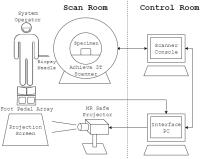 |
18 |
A Simple Scanner Control Technique for Device Localization
during MRI-Guided Percutaneous Procedures 
Matthew Alexander MacDonald1,2, Adam C. Waspe3,4,
Joao Amaral3,4, and Samuel Pichardo1,2
1Electrical Engineering, Lakehead University,
Thunder Bay, ON, Canada, 2Thunder
Bay Regional Research Institute, Thunder Bay, ON, Canada, 3Medical
Imaging, University of Toronto, Toronto, ON, Canada, 4Hospital
for Sick Children, Toronto, ON, Canada
An experiment demonstrates a simple technique for a
clinician operator to interactively align scan planes to an
interventional device within the scan room during an MRI
guided procedure. Input is collected using foot pedal
switches to select axial/device intersection points to
specify a virtual line of best fit about which auxiliary
views are aligned automatically. Volunteer operators
position a biopsy needle within an ex vivo porcine specimen
while interactively tracking the needle position and
measurements are taken to assess the technique's efficiency.
|
|
3590.
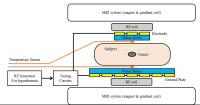 |
19 |
Experimental study of MR Compatible RF Hyperthermia System 
Han-Joong Kim1, Jong-Min Kim1,
Young-Seung Jo1,2, Suchit Kumar1,
Seong-Dae Hong1, Chulhyun Lee2, and
Chang-Hyun Lee1
1Electronics and Information Engineering, Korea
University, Seoul, Korea, Republic of, 2The
MRI Team, Korea Basic Science Institute, Cheongju, Korea,
Republic of
Many reports suggest that hyperthermia is very effective
treatment for tumor therapy. In this work, MR compatible RF
hyperthermia system is presented for a 3.0 T MRI. Phantom
and animal experiments have been conducted and the results
compared with the simulations results for tumor and tissue
model. They are in very good coincidence with each other,
which confirms the utility and feasibility of the MR
compatible RF hyperthermia system with capacitive driving.
|
|
3591.
 |
20 |
Tracking of a Robotic Device by Controlling the Visibility of
Markers from the Robot Control 
Junmo An1, Eftychios G. Christoforou2,
Karen Chin3, Jeremy Hinojosa3, Dipan
J. Shah3, Andrew G. Webb4, and
Nikolaos V. Tsekos1
1University of Houston, Houston, TX, United
States, 2University
of Cyprus, Nicosia, Cyprus, 3Houston
Methodist, Houston, TX, United States, 4Leiden
University Medical Center, Leiden, Netherlands
Integrated control system of the manipulator and marker
control is important for localization and tracking of
multiple optically detunable MR markers on MR-compatible
manipulators. Selecting which markers are visible on MR
images by the motion of the maneuvering portion of the
MR-compatible manipulators allows unambiguous identification
of a combination of markers and simplifies both the data
acquisition and the post processing. This proposed technique
can be employed to track multiple marker positions on
interventional devices such as the steerable catheters and
the end-effectors of the MR-compatible manipulator.
|
|
3592.
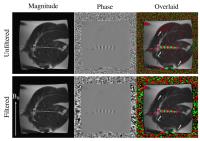 |
21 |
Visualization of interventional devices by transient, local
magnetic field alterations using bSSFP sequences -
Permission Withheld
Frank C Eibofner1, Hansjörg Graf1, and
Petros Martirosian1
1University Hospital Tübingen, Tübingen, Germany
A technique for the visualization of interventional devices
by use of transient, local magnetic field alterations and
bSSFP sequences is presented. It allows the generation of
distinct artifacts with controllable dimension. The
instrument is visualized in the phase image obtained in the
same scan as the undisturbed anatomical image. Localization
is done by subsequent superposition.
|
|
3593.
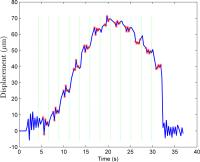 |
22 |
On Demand Reprogramming of MR Sequence Parameters Using MatMRI 
Samuel Pichardo1,2, Charles Mougenot3,
Steven Engler1,4, Adam C. Waspe5,6,
and James Drake5,6
1Thunder Bay Regional Research Institute, Thunder
Bay, ON, Canada, 2Electrical
Engineering, Lakehead University, Thunder Bay, ON, Canada, 3Philips
Healthcare, Toronto, ON, Canada, 4Computer
Science, Lakehead University, Thunder Bay, ON, Canada, 5University
of Toronto, Toronto, ON, Canada, 6The
Hospital For Sick Children, Toronto, ON, Canada
For dynamic studies, it is often desirable to adjust
parameters in “real time” depending on decisions made by
user-defined algorithms. We performed a modification to the
software tool MatMRI to develop a method that allows
changing on demand multiple MR sequence parameters. We
present results of this new method when applied to the
modification of sequence parameters for MR-Acoustic
Radiation Force Imaging. Our results demonstrate that it is
feasible to reprogram MR sequence parameters dynamically
using existing technology for the control of scanners.
|
|
3594.
 |
23 |
Efficient respiratory navigator-based 4D MRI 
Sascha Krueger1 and
Tim Nielsen1
1Philips GmbH, Innovative Technologies, Research
Laboratories, Hamburg, Germany
4D image data are used in radiation therapy planning to
estimate motion of the tumor or regions at risk. Today 4D CT
is commonly used for this purpose. Due to better soft tissue
contrast and quantitative and functional imaging, a clinical
demand for MRI in therapy planning exists. Consequently,
there is also a growing interest in 4D MRI techniques. A
scan-time-efficient 4D MRI method utilizing the MRI
Navigator as motion sensor with high geometric fidelity is
proposed.
|
|
3595.
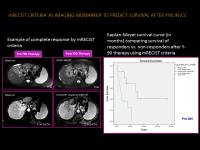 |
24 |
MR imaging patterns of Cholangiocarcinoma and post-intervention
features: A case-based approach -
Video Not Available
Juan C Camacho1, Courtney Moreno1,
Peter Harri1, and Pardeep Mittal1
1Department of Radiology and Imaging Sciences,
Emory University School of Medicine, Atlanta, GA, United
States
Cholangiocarcinoma may demonstrate typical imaging
manifestations and common patterns of organ involvement,
guiding diagnosis, and facilitating imaging follow up after
therapy. Adequate knowledge of tumoral biology in
cholangiocarcinoma and current image-guided therapeutic
approaches, along with imaging appearance of
cholangiocarcinoma before and after image-guided
interventions is crucial for adequate diagnosis and
surveillance .MR imaging plays a key role for patient
management, assessing therapy response and patient
surveillance.
|
|